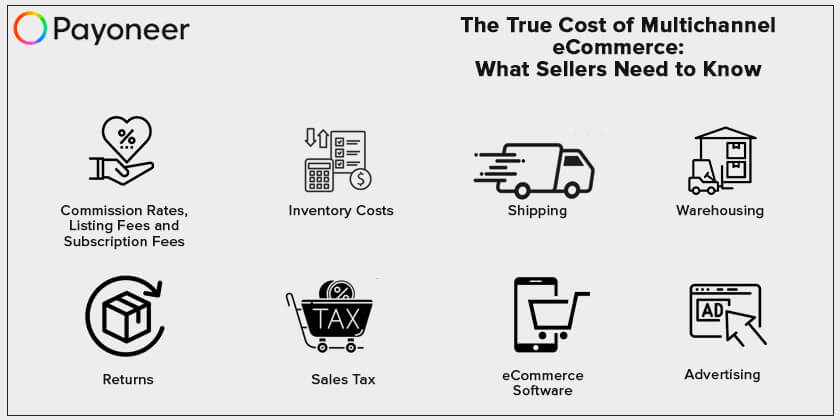
The True Cost of Multichannel eCommerce: What Sellers Need to Know
Editor’s note: This is a guest post written by Allison Lee, Content Lead at Zentail, an eCommerce operations platform for multichannel merchants
There are approximately 1.8 million eCommerce sellers in the U.S. with many more to come as consumers make the mass exodus online in the wake of the current COVID-19 pandemic.
Needless to say, the barrier to entry for sellers is low while the potential opportunity is high. However, only a minority of sellers survive the first year, let alone the first 120 days according to recent surveys.
A lot of it boils down to this: having the right expectations. This is especially true for sellers looking to expand beyond their webstore and compete on external marketplaces. Running a multichannel business can come with a surprisingly hefty price tag if costs aren’t managed well.
Here’s a breakdown of the fees, average costs and investments you’ll need to anticipate as you dive into the world of multichannel eCommerce.


1. Commission Rates, Listing Fees and Subscription Fees
These are the basic, upfront fees you pay to get started on third-party channels. While Amazon charges a subscription fee for selling on its platform (where professionals pay $39.99 per month), eBay and others are free to get started but may instead charge listing fees (eBay’s ranges from free to $0.25 per listing, depending on how many SKUs you have) in addition to commission.
Commission rates are variable across most channels. They’ll usually range between 6% to 20% depending on the product category and are calculated from the total sales price, i.e., your item price plus shipping and handling.
None of these fees should take you by surprise. They’re largely straight-forward and consistent on every channel.
2. Inventory Costs
This is where a lot of businesses get hung up. Poor inventory management is estimated to be a $1.75 trillion problem annually, with $642.6 billion in losses stemming from preventable returns, $634.1 billion coming from out-of-stocks and $471.9 billion coming from overstocks.
“Holding costs can be especially deadly,” says Daniel Sugarman, CEO of eCommerce operations platform, Zentail. “They normally account for 30% or more of a seller’s working capital—which translates to tons of wasted cash that could’ve been spent on products that actually bring in revenue.”
Truth be told, everyone from a mom-and-pop shop to Nike is vulnerable to errors when it comes to inventory tracking or demand forecasting. The latter lost $100 million in the early 2000s, when it onboarded to a new inventory system that was found to be buggy and full of inaccurate forecasts.
As a multichannel seller, there are even more factors that you have to keep track of, like varying user behaviors and concurrent sales. Those who struggle most either fail to adapt to new, more automated ways of calculating demand in real time, or resort to using cheap, low-quality or disparate software solutions to handle this critical task.


The bottom line: you’ll need to keep close watch over your inventory and vet software with a discerning eye. Keep in mind that you not only need an accurate way to calculate future sales—you also need a way to sync existing inventory and sales to avoid overselling on any channel. Overselling itself is a slippery slope: canceled orders could mean bad reviews, which could lead to lower visibility on channels, suspension and additional costs trying to rebuild your business.
3. Warehousing
A larger online footprint warrants more physical space to store your products. However, warehousing can become a bottleneck for a variety of reasons.
Contracting, for one, is a difficult task riddled with negotiation and hours of research. Now that your business is attracting more sales across a wider region and isn’t tied down by regular store hours, you need to find a warehouse(s) that can service your buyers at the speed that each channel requires.
The more warehouses you have, the more fees you’ll have to juggle, and some lessors may hike up rates over time. Even if you go with a service like Amazon FBA, which offers virtually limitless warehouse space, you have to anticipate less-obvious costs like long-term storage fees or inventory removal fees.
There are other alternatives out on the market now—namely, 3PLs. 3PLs, such as ShipBob and Deliverr, offer FBA-like services across many channels. Most multichannel sellers opt for a hybrid approach; they’ll use FBA to remain competitive on Amazon, but tap 3PLs to avoid over-reliance on it. (Some channels like Walmart also forbid the use of FBA, forcing sellers to diversify.)
For ballpark numbers, it’s estimated that an eCommerce supply chain requires up to three times more warehouse and logistics space than a traditional brick-and-mortar supply chain.
4. Shipping
Shipping, of course, is a cost you’ll have to factor in. Here are several things to keep in mind, though, as you try to predict your costs:
- Two-day delivery is becoming the industry norm
- If you’ve got various units of an order located in multiple warehouses, you could be paying more in shipping fees per order
- Choose to use multiple couriers with varying rates
- When selling globally, you face international shipping rates and tariffs
- Freight costs are rising exponentially as COVID-19 is restricting transportation lines
- Fulfillment partners, like FBA, charge inbound shipping and ‘pick and pack’ fees
- Packaging and presentation are additional costs to factor in
- Consider the cost of returns shipping
- Don’t forget about any additional shipping options like tracking or insurance
5. Returns
This deserves a callout all its own, considering how 15% to 40% of online purchases are returned (compared to 5% to 10% of in-store purchases). That number is potentially higher on Amazon, where Prime members are accustomed to returning items just as frequently as they purchase.
The downside of this is that items may be unsellable once returned. If you’re fulfilling through a service like FBA, an out-of-house employee will make the judgement call and may force you to get rid of inventory at your own expense.
In addition to this, it’s not uncommon for marketplaces to automatically offer a full refund to buyers regardless of the reason. Many may even put the onus on you to pay return shipping and restocking fees, which could be as high as 20% of your item price.
6. eCommerce Software
As your workload multiplies, you’ll either be hiring more hands or tapping software to help carry the load. Modern systems range from free to several thousands of dollars a month. They also range from having a singular focus to supporting your end-to-end operations.


In many cases, you get what you pay for. The greatest mistake you could make at this stage is underestimating the value of software, and waiting until issues arise to find a reliable, automated solution.
Note that eCommerce is a particularly finicky industry to be in, as marketplaces are constantly changing their requirements and a single listing error or poor customer experience could tank your sales overnight. Without the right systems in place, it’s humanly impossible to operate at the level and speed that eCommerce requires.
7. Advertising
As online competition heats up, online sellers face higher costs to acquire a single customer. At the start of 2020, acquisition costs were “prohibitively high” for many direct-to-consumer brands.
While the pandemic and the resulting dip in media costs provided some relief, acquisition costs are expected to rise again once the pandemic subsides. Advertising is, in some cases, now a prerequisite to compete. For example, sponsored products dominate the first page and ‘recommended products’ sections of Amazon.
Even on newer channels like Walmart Marketplaces, where few sellers currently participate in ads, you’re encouraged to capitalize on the early-mover advantage and recognize the impact ads have on your organic rankings (think: the Flywheel Effect).
8. Sales Tax
Since the South Dakota v. Wayfair ruling in 2018, eCommerce sellers have become increasingly responsible for collecting and remitting sales tax.
Pre-2018, you were only responsible for collecting tax in states where you had physical nexus. Now, you may be responsible for collecting taxes in places you’ve never set foot. The new, additional criteria is based on how many sales you’ve made from buyers within a given state.
These economic thresholds are determined at the state level. But between the local, district and state levels, there are approximately 4,000 different tax jurisdictions within the U.S.
As you can imagine, the rules get tricky—really tricky. And there are also things called marketplace facilitator laws, which help you by shifting the burden to the marketplaces themselves. However, you still need to be able to determine where you (versus the marketplace) need to collect taxes. This will, obviously, have an impact on your overall profitability. Failure to comply will additionally result in violation fees.
Conclusion
Multichannel eCommerce is still a very lucrative business to be in, and arguably a safer strategy than a single-channel one. A whopping 92% of sellers reportedly saw some type of growth within the first year of expanding to a second channel.
However, it’s important to know how to properly gauge costs and set attainable goals. With the right foundation in place, you can enter the fast-paced, exciting world of multichannel ecommerce with great confidence.




